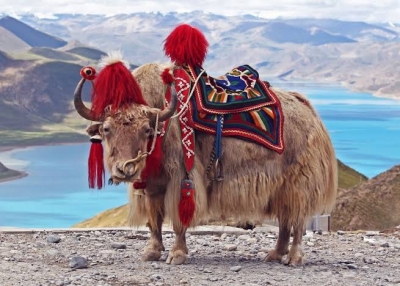
Yaks may be described as heavier versions of domestic cattle, with long woolly hair and bulky frames. The yak is usually found in the treeless uplands of the Himalayas, between 3,000 and 5,500 m.
The yak is built to survive high altitudes. Its coat is so thick and warm that, if required, the yak can sleep directly on snow. It has a large heart and lungs to help it breathe in the thin mountain air. Its hooves and horns are adapted to break ice from the frozen ground so that it can graze on the grass below. It can go without food and water for many days. It is also used as a pack animal to carry provisions and to plough fields.
Every part of the yak is useful, including its hair, horns, skull, skin and dung. It also provides meat and its rich, fatty milk is made into yak butter, cheese and yoghurt.
Yak milk is used to make a Himalayan speciality- butter tea. The Tibetan butter lamp festival, which is held in December, traditionally uses clarified yak butter in the lamps. Every year, Tibetan monks line the streets with intricate butter sculptures, as part of a centuries old Buddhist tradition to ward off epidemics, hunger and war. The yak is intricately linked to the lives and values of the Himalayan people and it is indispensible to them. It faces a threat from rising temperatures due to global warming and habitat loss.
Picture Credit : Google



